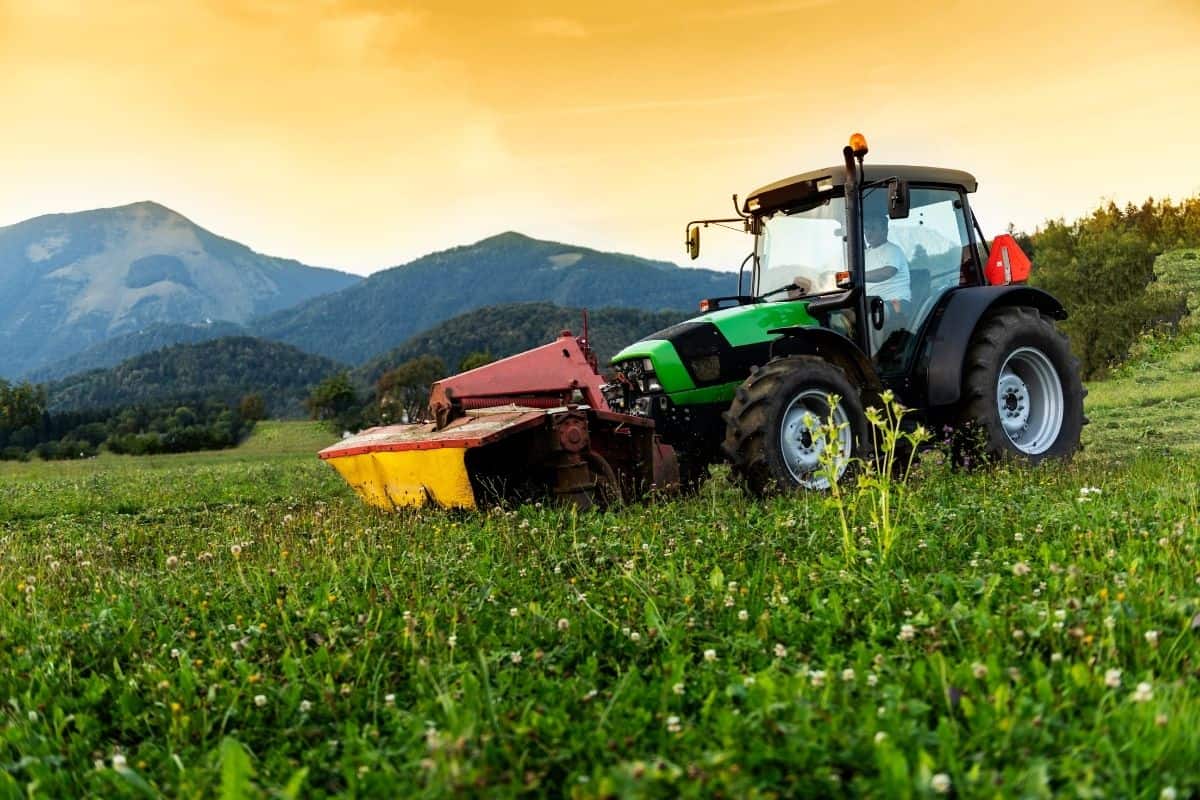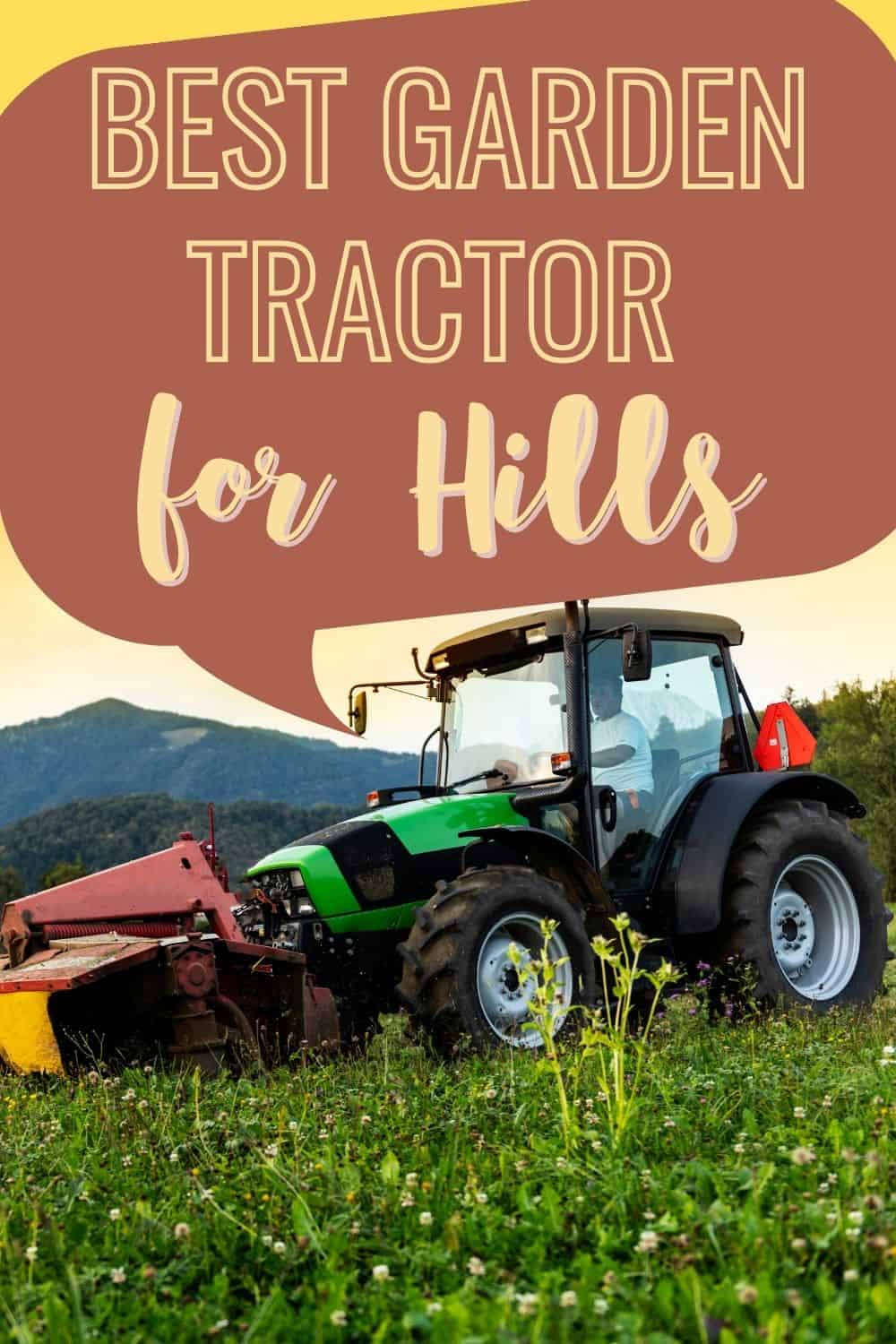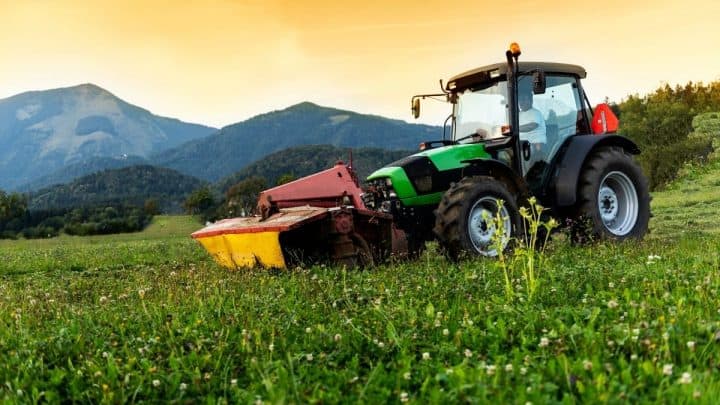What is the best garden tractor for hills? Do you even need a garden tractor to keep the parts of your yard that lie on a slope trimmed and trash-free?
There’s a huge market filled with options for finding the best garden tractor, best riding lawn mower, or, for a very few yards, the best push mower for steep hills and rough terrain.

In this article, we will tell you everything you need to know about the best garden tractors for hills, but first, we will do a quick review of basic safety principles for hillside mowing.
Tired of a hilly yard? Here’s what it would cost to level a yard.
7. Safety Considerations for Choosing the Best Mower for Slopes
According to the Consumer Product Safety Commission, rider mower accidents cause 80,000 injuries a year in the United States, 5,000 of them to children. An average of 70 people a year are killed on rider mowers. This means that the best riding mowers for hills are always the mowers that keep you safe.
Whether you use a riding lawn mower or a small garden tractor, whether it has a manual transmission or automatic transmission, or even if you use a fleet of electric mowers to cut grass on uneven terrain, the only good choice in mowing equipment is the mower that keeps you safe.
Here is what you need in a great choice of the best mower for mowing grass on a hilly slope or tackling irregular elevations across a large lawn.
1. You need to be able to get off your mower safely when an accident occurs
Any garden tractor or rider mower for hillside mowing needs a safe exit. You don’t want to risk falling under your mower as it falls down a slope.
Your seat should be closer to the rear wheels than to the front wheels, and as far away from any moving parts as possible. The steering wheel should be mounted, so there is no way it can crush your chest.
2. Your mower needs to be designed to keep you upright at all times
Tipping and rollovers are disastrous on riding mowers and garden tractors. To keep them from happening, it’s best to have the cutting deck in front of your mower. Deck sizes need to be proportional to cab sizes.
You don’t want a cutting deck so large that it pulls your mower to the side when you are cutting grass on a hilly slope. And you want the fuel tank placed where it balances the cutting deck.
3. The cutting deck should be at the front of the mower
You want a mower that cuts grass and brush in front of the operator, not behind the operator. When the cutting deck is in front of the mower, the operator does not constantly have to glance back to check on the operation of the cutting deck.
4. You need a mower with an engine that shuts off when you are not on the machine
Among the special features of any candidate for the best mower for slopes is a lanyard that cuts off the engine instantly when the operator is not on the machine. The best mower safety features include a cut-off when the operator is out of safe operating position on the seat of the mower.
5. The seat of your mower should keep the operator upright at all times
Just because the mower is on a slope doesn’t mean the operator should be on a slope. The high-back seat should tilt to keep the operator upright regardless of the slope of the yard being cut.
The controls need to be ergonomic, too, moving with the arms of the seat. The best option in mower controls will be joysticks in the arms of the seat, which stays upright no matter where the mower is on rough terrain.
6. Your mower should have a powerful engine to ensure you maintain forward momentum
Accidents happen when mowers get bogged down in brush and tall grass. Your mower needs a powerful engine running the cutting deck and propelling your machine forward.
The 11.5 HP Briggs and Stratton Power Built 4-Cycle OHV Engine is an example of an engine that is strong enough for mowing gentle slopes. For really steep slopes, you might need something like the 25 HP Yanmar water-cooled turbo diesel engine offered by Kut Kwick.
7. Here’s one final thing to consider
The best mower for a slope steeper than 15° is always going to be a tractor mower, not a rider mower. There are tractor mowers that can be operated safely on slopes as steep as 40°. They will have a cab to protect the operator in a rollover. They will have seat belts that allow the operator to strap in, just like driving a small truck.
You never want to have to fight gravity to stay on your machine. You never want to use a zero-turn lawnmower on a hillside, because it is not weighted to stay upright. Older zero-turn mowers will turn over on a hill. It doesn’t do any good to have a mower with a tight turning radius if its weight is not distributed, so it stays upright on a slope.
Safety Rules for Operating Your Best Choice for Mowing Hills
The best option among the many choices in today’s complicated tractor mower and rider mower market will give you the power you need to get your mowing done in less time.
The right mower for you will enable you to do lawn care at a lower cost. It will have just the special features you need.
The best garden tractor for hills will always enable you to follow these rules.
1. Always mow up and down the hill with a garden tractor, not across it
You should never use your garden tractor’s zero-turn feature on a slope. Use it on level ground at the top of a slope, so you can turn around to mow downhill after mowing uphill. Then use the zero-turn feature again at the bottom of the slope.
2. Always have an escape route
Your riding mower or garden tractor must allow you to see a path to safety in case your engine kicks out of gear or your brakes fail or both. You need to be able to see the front tire highest on the hill to make sure it is leaving a depression in the grass. If it isn’t, you need to be able to slowly turn downhill to return to safety.
3. Always use brakes for stopping, not for slowing down the motor
Stop the garden mower with brakes. Slow down the motor through the transmission. A hydraulic transmission will be more responsive.
If you try to slow down mowing by setting the parking brake, the rear wheels will lock, and you will slide down the hill.
4. Choose a ground speed that allows you to get up and go down the hill without shifting gears
You need to be able to keep your engine’s RPM up to power the blades while using the transmission to move at a safe speed.
5. Keep in mind that the slope around a walk-out basement is too steep for up-and-down mowing
To mow around the opening to a walk-out basement, mow down and then drive around to mow down the slope again. Never try to mow up an embankment around a walk-out basement. Driving around takes longer but keeps you safe.
Now let’s take a look at the best brands of rider mowers and garden tractors for mowing slopes.
Our Choices for Best Garden Tractor for Hills
1. Husqvarna TS 354XD (54″) 24HP Kawasaki Garden Tractor
Part of Husqvarna’s 300 series of rider mowers, the Husqvarna-345XD was designed for homes and landowners who need a reliable, powerful machine with a wide cutting edge that they can use year-round.
The 24 HP Kawasaki engine is powerful enough to deal with tall grass and brush while giving you a comfortable ride. The ground-engaging transmission with electronic locking differential enhances safety and efficiency on slopes and slippery ground.
Pros:
- 54-inch mowing width speeds up mowing tasks
- Easy to steer
- Sturdy construction
- Tight (although not zero) turn radius
- Mower height adjustment on the left, won’t be thrown off by cuttings and debris coming out on the right
Cons:
- Hard to get off the skid it is shipped on. Instructions say just to roll it off the skid, but many buyers report having to use a chainsaw and sledgehammer to break off the skid to get the mower out
- Takes two people to install the seat because of its weight
- Opening to the fuel tank is small: you may need a funnel to refuel your mower
- Sensitive safety sensor under the seat. Anytime you take your weight off the seat, the motor will stop
Many of these problems can be dealt with by buying directly from a dealer, but you may get a lower price on Amazon.
2. Kut Kwick Slopemaster
The American-made Kut Kwick Slopemaster was designed for mowing steep slopes up to 40°. It is engineered so its weight is transferred to its wheels, keeping the structure stable on sloping ground. It is a true zero-turn mower, taking turns with a radius of less than an inch so there are no rows of uncut grass. The Kut Kwick Slopemaster’s zero-turn ability also makes it easy to avoid bird nests, trash, and young trees.
The Kut Kwick Slopemaster can trim vertical edges of concrete at walkways and overpasses. And it’s rear discharge decks eliminate the risk of throwing objects that can hit pedestrians and passing cars.
Kut Kwick advertises that its Kut Kwick Slopemaster is so efficient that it can eliminate 90% of the labor cost of mowing slopes. That’s a good thing because its MSRP is $64,999.
Pros:
- Weight-bearing wheels for maximum stability
- Cutting deck in front of the mower, no need to look backward to monitor the progress of the job
- Ergonomic seat and controls, so the operator is always upright
- Maneuverable around obstacles whether going uphill or downhill
- Financing is available for businesses that need the machine immediately
Cons:
- Priced out of reach of most homeowners and small landowners.
FAQs about the best garden tractors for hills
Can you really use a riding mower on hills and steep slopes?
For anything other than a very short slope, maybe 10 feet at most, a garden tractor offers a much safer operation than a rider mower. For very steep slopes, steeper than 15°, a dedicated machine like those by Kut Kwick is required for safety reasons.
There are many common situations in which riding mowers simply aren’t safe. You should never use them to cut the grass on the sides of a walk-out basement. You should never use them to trim the grass on the edges of a bridge or overpass. In these situations, you need to hire someone who has a mower like the Kut Kwick Slopemaster or use other kinds of ground covers that don’t need mowing.
Can you use a riding lawn mower on hills?
Riding mowers are suitable for mowing up and down gentle slopes if they have certain safety features described in the net answer.
What type of riding lawn mower is best for hills?
Don’t even consider a riding lawn mower for mowing hillsides unless you have roll-over protection and a seat belt or a ground-engaging transmission to deal with slippery slopes. And remember, mow up and down hills, not across them.
What is the best mower for steep slopes?
Using Kut Kwick mowers, or hiring someone who uses Kut Kwick mowers, is your best bet for steep slopes. The safest way to mow gentle slopes is to mow downhill, then go around to the top of the hill by a gently sloping route and mow the next strip, going down the hill again. You are less likely to have a rollover accident if you don’t mow up the hill just down.
Are hydrostatic mowers good for hills?
Hydrostatic mowers grip the ground. They are safer on hills and slick surfaces.
What is the best lawn mower for rough terrain?
A. Rough, brushy, uneven terrain is easier for a mower to handle if it has a powerful engine. Any of the mowers we recommend that has an engine of 24 HP or more can handle tall grass and rough terrain.
Why are zero turns bad on hills?
Zero turns at the bottom of a hill put an enormous strain on the transmission. They are only slightly safer at the top of a hill but would be OK on flat ground at the crest of a hill. Don’t do zero turns on slopes.
How do you mow a steep hill with a tractor?
Always take a quick look over the ground you want to mow first, so you will be aware of limbs, trash, bird nests, and flowers you do not want to put through your cutting deck. Then take the long way around to start at the top of the hill and mow down. Take a wide turn on flat ground at the bottom of the hill and mow the next row. Turn around on the flattest ground you can find at the top of the hill and repeat the process.
How do you mow a slope on a riding mower?
A. Be aware that some slopes are just too steep for a riding mower. If you are cutting grass on a gentle slope with a riding mower, mow downhill only. Go around and start the next row from the top of the hill. Avoid sharp turns.
Can we use push lawn mowers on sloping hills?
Push mowers with a cut-off feature are safe on a sloping hill. Turning them around at the bottom of the hill, however, takes a lot of muscle power. It’s best to have some flat ground on which to turn around before pushing the mower back up the hill.
Don’t use a push mower to mow across a hill. There’s a real danger of overturning the mower. Engine cut-off won’t be instant, and serious injury can result.
Alternatives To Grass On A Hilly Yard
If you’d rather not have to mow grass on a hilly yard, there are alternatives that are a lot easier to maintain than grass. Here are some ideas:
Ground covers
- Creeping thyme is a low-growing perennial herb thart forms a dense mat of foliage and produces small, fragrant flowers. It’s drought-tolerant and can handle some foot traffic.
- Sedums are succulent plants well-suited to rocky or hilly terrain. They require minimal maintenance and come in different colors and textures.
- Groundcover roses will provide colorful blooms while covering the ground effectively.
Native plants
- Native grasses – while you want to avoid traditional grass, some native grasses are better adapted to hilly terrain and require less maintenance. Examples include buffalo grass and blue grama grass.
- Wildflowers can create a beautiful, low-maintenance landscape. Choose species that thrive in your region’s climate and soil conditions.
Drought-tolerant plants
- Yarrow is a hardy perennial that requires little water once established and comes in various colors.
- Lavender is drought-tolerant, aromatic, and adds a touch of elegance to your landscape.
- Sage – many varieties of sage are well-suited to dry conditions and can provide color and texture to your yard.
Plants that help avoid erosion
- Juniper – certain juniper varieties can help stabilize the soil on slopes due to their extensive root systems.
- Cotoneaster shrub provides ground cover and can help with erosion control.
Mulch and gravel
If your hilly areas is not too large, you can use mulch or gravel to cover it for a low-maintenance, aesthetically pleasing solution.
Terracing
If your yard has a steep slope, consider terracing it with retaining walls or steps, and then plant low-maintenance plants in the terraced areas.










How Much Does It Cost To Level A Yard? Quick Guide To Regrading Your Property
Tuesday 22nd of March 2022
[…] best garden tractor for hills […]